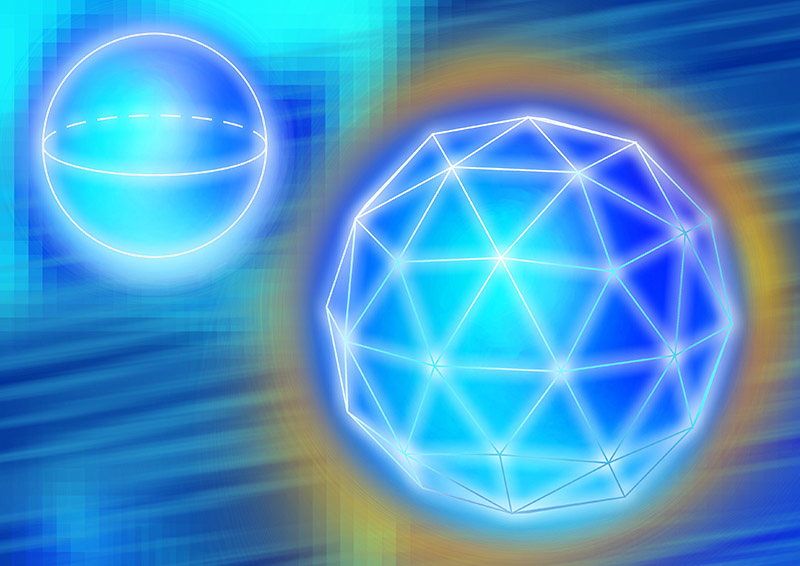Highlights
New principle may help explain why nature is quantum

A principle of 'accepting the facts' implies that a quantum bit (typically pictured as a 'Bloch ball') can look like a sphere but not like a polyhedron. Polyhedral bits have been linked to theories of discrete spacetime. By ruling out various alternative theories of nature, the principle may help to explain why the world is quantum.
Image: Timothy Yeo / CQT, National University of Singapore
CQT researchers Stephanie Wehner and Corsin Pfister made this short video about their findings and provide a more detailed lay summary of their work here.
Like small children, scientists are always asking the question 'why?'. One question they've yet to answer is why nature picked quantum physics, in all its weird glory, as a sensible way to behave. CQT researchers Corsin Pfister and Stephanie Wehner tackle this perennial question in a paper published 14 May in Nature Communications.
We know that things that follow quantum rules, such as atoms, electrons or the photons that make up light, are full of surprises. They can exist in more than one place at once, for instance, or exist in a shared state where the properties of two particles show what Einstein called "spooky action at a distance", no matter what their physical separation. Because such things have been confirmed in experiments, researchers are confident the theory is right. But it would still be easier to swallow if it could be shown that quantum physics itself sprang from intuitive underlying principles.
One way to approach this problem is to imagine all the theories one could possibly come up with to describe nature, and then work out what principles help to single out quantum physics. A good start is to assume that information follows Einstein's special relativity and cannot travel faster than light. However, this alone isn't enough to define quantum physics as the only way nature might behave. Corsin and Stephanie think they have come across a new useful principle. "We have found a principle that is very good at ruling out other theories," says Corsin.
In short, the principle to be assumed is that if a measurement yields no information, then the system being measured has not been disturbed.
Quantum physicists accept that gaining information from quantum systems causes disturbance. Corsin and Stephanie suggest that in a sensible world the reverse should be true, too. If you learn nothing from measuring a system, then you can't have disturbed it.
Consider the famous Schrodinger's cat paradox, a thought experiment in which a cat in a box simultaneously exists in two states (this is known as a 'quantum superposition'). According to quantum theory it is possible that the cat is both dead and alive — until, that is, the cat's state of health is 'measured' by opening the box.
When the box is opened, allowing the health of the cat to be measured, the superposition collapses and the cat ends up definitively dead or alive. The measurement has disturbed the cat.
This is a property of quantum systems in general. Perform a measurement for which you can't know the outcome in advance, and the system changes to match the outcome you get. What happens if you look a second time? The researchers assume the system is not evolving in time or affected by any outside influence, which means the quantum state stays collapsed. You would then expect the second measurement to yield the same result as the first. After all, "If you look into the box and find a dead cat, you don't expect to look again later and find the cat has been resurrected," says Stephanie. "You could say we've formalised the principle of accepting the facts", says Stephanie.
Corsin and Stephanie show that this principle rules out various theories of nature. They note particularly that a class of theories they call 'discrete' are incompatible with the principle. These theories hold that quantum particles can take up only a finite number of states, rather than choose from an infinite, continuous range of possibilities. The possibility of such a discrete 'state space' has been linked to quantum gravitational theories proposing similar discreteness in spacetime, where the fabric of the universe is made up of tiny brick-like elements rather than being a smooth, continuous sheet.
As is often the case in research, Corsin and Stephanie reached this point having set out to solve an entirely different problem altogether. Corsin was trying to find a general way to describe the effects of measurements on states, a problem that he found impossible to solve. In an attempt to make progress, he wrote down features that a 'sensible' answer should have. This property of information gain versus disturbance was on the list. He then noticed that if he imposed the property as a principle, some theories would fail.
Corsin and Stephanie are keen to point out that it's still not the whole answer to the big 'why' question: theories other than quantum physics, including classical physics, are compatible with the principle. But as researchers compile lists of principles that each rule out some theories to reach a set that singles out quantum physics, the principle of information gain versus disturbance seems like a good one to include.
Corsin joined Stephanie's group as a PhD student in 2012, having previously spent time at CQT working on his Master's thesis. Stephanie is a Principal Investigator at CQT and Assistant Professor in the NUS School of Computing.
The research is published as "An information-theoretic principle implies that any discrete physical theory is classical", Nature Communications, doi:10.1038/ncomms2821 (2013); arXiv:1210.0194.
This result is also reported in various media including PhysOrg, ScienceDaily and NanoWerk.






